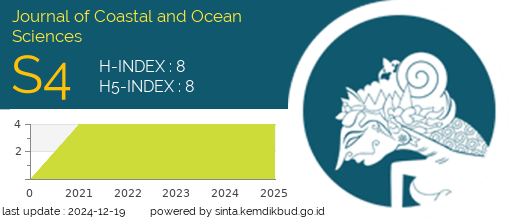Diversity and Distribution Patterns of Macrozoobenthos in the Intertidal Zone of Pasumpahan Island, Padang City, West Sumatra Province
DOI:
https://doi.org/10.31258/Keywords:
Diversity, Macroozoobenthos, Pasumpahan IslandAbstract
Macrozoobenthos are organisms that live sedentary (sessile) and have varying adaptability to environmental conditions. In addition, the level of diversity found in the aquatic environment can be used as an indicator of pollution. The purpose of this study was to determine the type, abundance, diversity, and distribution pattern of macrozoobenthos in the intertidal zone. This research was conducted in the waters of Pasumpahan Island. The method used in this study was a survey method, while sampling was carried out using three stations and each station consisted of 3 transects and three sub-zones using a 1m x 1m quadrant map. The results of this study found that the abundance value at each station was 4.22-5.78 ind/m2, while the abundance in the sub-zone ranged from 3.00-7.67 ind/m2, the diversity index (H') at the study sites ranged from 1.65-2.31, which means 1.0 ≤H' < 3.0 and the diversity of macrozoobenthos at the study site was categorized as moderate. The distribution pattern (Id) of macrozoobenthos at locations was clustered with a value of 1.05-1.28. The results of the One Way ANOVA test between stations obtained a value of 0.001 where p <0.05, which means H0 was rejected and there was a significant difference between the 3 stations, followed by the LSD test to find out which average between stations was the most different real
Downloads
References
Arbi, U.Y. (2012). Komunitas Moluska di Padang Lamun Pantai Wori, Sulawesi Utara. Jurnal Bumi Lestari, 12(1): 55-65
Bai'un, N.H., Riyantini, I., Mulyani, Y., Zallesa, S. (2021). Keanekaragaman Makrozoobentos sebagai Indikator Kondisi Perairan di Ekosistem Mangrove Pulau Pari, Kepulauan Seribu. JFMR (Journal of Fisheries and Marine Research), 5(2): 227-238.
Barus, T.A. (2004). Pengantar Limnologi Studi Tentang Ekosistem Air Daratan. Medan: USU Press
Febrita, E. (2015). Keanekaragaman Gastropoda dan Bivalvia Hutan Mangrove Sebagai Media Pembelajaran Pada Konsep Keanekaragaman Hayati Kelas X SMA. Jurnal Biogenesis, 11(2): 119-128.
Hamidy, R. (2010). Struktur dan Keragaman Komunitas Kepiting di Kawasan Hutan Mangrove Stasiun Kelautan Universitas Riau, Desa Purnama Dumai. Skripsi. Pekanbaru: Universitas Riau.
Mucha, A.P., Vasconcelos, M.T.S.D., Bordalo, A.A. (2003). Macrobentic Community in the Douro Estuary Relation Eith Trace Metals and Natural Sediment Characteristic. Environment Pollution.
Rahman, F.A. (2009). Struktur Komunitas Makrozoobentos di Perairan Estuaria Sungai Brantas (Sungai Porong dan Wanokromo), Jawa Timur. Jurnal Ilmu Pertanian Indonesia, 24(2): 88-90.
Rifardi. (2008). Tekstur Sedimen, Sampling dan Analisis. Pekanbaru: UNRI Press.
Riniatsih, I. (2007). Kelimpahan dan Pola Sebaran Kerang-Kerangan (Bivalve) di Ekosistem Padang Lamun, Perairan Jepara. Jurnal Ilmu Kelautan, 12(1): 53-58.
Satria, M. (2014). Keanekaragaman dan Distribusi Gastropoda di Perairan Desa Berakit Kabupaten Bintan. Skripsi. Tanjung pinang: Universitas Maritim Raja Ali Haji.
Werdiningsih R. 2005. Struktur Komunitas Kepitig di Habitat Mangrove, Pantai Tanjung Pasir, Tangerang, Banten. Skripsi. Fakultas Matematika dan Ilmu Pengetahuan Alam. Institut Pertanian Bogor. Bogor
Yulihatul, M., Wayan, I.R., Dewa, A.A.P. (2019). Struktur Komunitas Makrozoobenthos Sebagai Indikator Kualitas Perairan di Pantai Serngan, Bali. Journal of Marine and Aquatic Sciences, 5(1): 36-43.






